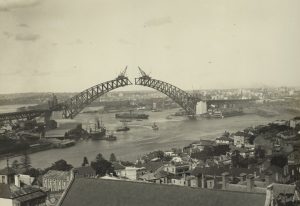The International Day for Monuments and Sites, better known as World Heritage Day, is celebrated annually on 18 April. Here is create’s pick of seven iconic heritage industrial sites from across Australia.
Our built environment is populated by sites of industrial heritage, linking those of us in the present to the engineering endeavours of the past, and also forming a testament for the future.
The theme for 2022, Heritage and Climate, is a chance to reflect on the impact of human industry on the environment, and on efforts for the conservation and protection of heritage sites nationally.
Sydney Harbour Bridge

The Sydney Harbour Bridge, which recently marked its 90th anniversary, is undoubtedly an iconic piece of Australian civil engineering.
Safety standards and methods of structural maintenance have developed over the decades, but this stalwart of Sydney Harbour continues to impress as a marvel of design as well as function.
Budj Bim eel traps
Heritage sites of human industry extend back far before the arrival of foreigners. The Budj Bim eel traps on Victoria’s south-west coast are over 6000 years old, predating both Stonehenge and the pyramids, and were crafted by Australia’s first engineers – Indigenous Australians.
The site is the first to be listed by Australian UNESCO World Heritage exclusively for its Aboriginal cultural values. The system of weirs, dams and stone canals were designed to trap eels and other aquatic life for food and trading purposes, and represent a prime example of aquaculture and hydraulic engineering.
Mary Valley Rattler
When considering items of industrial heritage, it’s often the big stuff that comes to mind – infrastructure, large buildings or notable landmarks, for example. But industrial heritage also encompasses movable heritage items such as vintage cars, X-ray machines and steam trains.
The Mary Valley Rattler, a heritage steam train passing through the picturesque Mary Valley near Gympie, Queensland, was built as an extension to the major railway artery along Queensland’s coast. Now a popular tourist attraction, the Rattler offers a chance to experience first-hand an icon of heritage railway engineering.
Parkes Radio Telescope
The Parkes Radio Telescope, situated at the Parkes Observatory in central New South Wales, was opened over 60 years ago and is still in operation. The single-dish telescope is the largest of its kind in the southern hemisphere dedicated to astronomy, boasting a dish with a diameter of 64 m.
Originally commissioned to conduct astronomy research, the telescope has also been used by NASA to receive data from spacecraft – it is renowned for its role in the 1969 Apollo 11 mission moon landing and was immortalised on screen in the film The Dish.
Victoria Pass
Constructed in the 1830s, Victoria Pass is a principal route across the Blue Mountains. The project was a significant technical achievement in the early years of road technology development, bypassing steeper descents to achieve passage across challenging mountain terrain.
As with many items of industrial heritage, Victoria Pass is a pertinent reminder of the impact of human industry on society – the pass was built using chain-gang convict labour.
Eveleigh Railway Workshops
Certain items of industrial heritage are prime for adaptive reuse. The Eveleigh Railway Workshops in Sydney began operations in 1882 for the purposes of locomotive maintenance and repair.
The space has seen much evolution over the years: during World War Two the facility was used to produce gun-shells; and currently occupying part of the site is Carriageworks, a hub for the performing and contemporary arts.
West Gate Bridge
Sadly, not all industrial heritage sites are cause for celebration, but also remembrance. The West Gate Bridge facilitates the passage of hundreds of thousands of Melbournians to and from the CBD each day.
During construction, however, in October 1970, part of the bridge collapsed into the Yarra River, killing 35 construction workers and injuring 18 others. Fragments from the collapsed section of bridge are now housed in a garden at Monash University’s Clayton campus to “remind future engineers of the consequences of errors”.